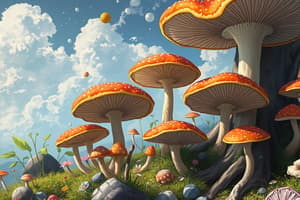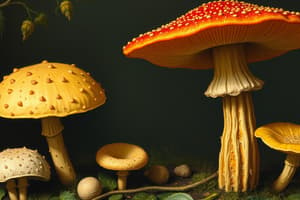Podcast
Questions and Answers
What distinguishes protozoans from fungus-like and plant-like protists?
What distinguishes protozoans from fungus-like and plant-like protists?
- Their size
- Their color
- Their heterotrophic feeding (correct)
- Their reproduction methods
What allows amoebas to change their shape and move?
What allows amoebas to change their shape and move?
- Their high metabolic rate
- The flexibility of their plasma membrane (correct)
- The presence of flagella
- Their rigid cell wall
What are pseudopods used for in amoebas?
What are pseudopods used for in amoebas?
- Reproduction
- Food storage
- Photosynthesis
- Locomotion (correct)
When at rest, what shape do amoebas generally maintain?
When at rest, what shape do amoebas generally maintain?
What is indicated by recent research about amoebas?
What is indicated by recent research about amoebas?
What defines protists as a separate kingdom?
What defines protists as a separate kingdom?
Which statement about fungi is accurate?
Which statement about fungi is accurate?
How do fungi acquire nutrients?
How do fungi acquire nutrients?
What is true about the classification of protists?
What is true about the classification of protists?
In what way can fungi be harmful?
In what way can fungi be harmful?
What is the primary function of the cilia in ciliates?
What is the primary function of the cilia in ciliates?
What occurs during the conjugation of ciliates like paramecia?
What occurs during the conjugation of ciliates like paramecia?
Which of the following is true about Balantidium coli?
Which of the following is true about Balantidium coli?
What role do contractile vacuoles serve in ciliates?
What role do contractile vacuoles serve in ciliates?
How does the Stentor ciliate feed?
How does the Stentor ciliate feed?
What kingdom do diatoms belong to?
What kingdom do diatoms belong to?
Which of the following statements best describes protists?
Which of the following statements best describes protists?
What is a key difference between protists and fungi?
What is a key difference between protists and fungi?
What question should one continuously ask when studying diverse life forms?
What question should one continuously ask when studying diverse life forms?
Which of the following is not a characteristic used to define protists?
Which of the following is not a characteristic used to define protists?
How do amoebas primarily move in their environment?
How do amoebas primarily move in their environment?
What is the primary purpose of contractile vacuoles in amoebas?
What is the primary purpose of contractile vacuoles in amoebas?
Which of the following amoebas is known to cause disease in humans?
Which of the following amoebas is known to cause disease in humans?
What is the primary method by which amoebas reproduce?
What is the primary method by which amoebas reproduce?
What environmental conditions can amoebas endure by forming cysts?
What environmental conditions can amoebas endure by forming cysts?
Which protozoan is responsible for causing African sleeping sickness?
Which protozoan is responsible for causing African sleeping sickness?
How do protozoans generally absorb their food?
How do protozoans generally absorb their food?
What is the primary role of Trichonympha in relation to termites?
What is the primary role of Trichonympha in relation to termites?
What distinguishes a ciliate from other protozoans?
What distinguishes a ciliate from other protozoans?
What is a prominent feature of Paramecium?
What is a prominent feature of Paramecium?
What type of cell structure do protists possess?
What type of cell structure do protists possess?
What organelles are commonly found in protists?
What organelles are commonly found in protists?
Which of the following is NOT a feature of protists?
Which of the following is NOT a feature of protists?
Which statement is true regarding the cellular structure of protists?
Which statement is true regarding the cellular structure of protists?
Which of the following statements is false about protists?
Which of the following statements is false about protists?
What is a key reason that unicellular protists are considered more complex than individual cells of multicellular organisms?
What is a key reason that unicellular protists are considered more complex than individual cells of multicellular organisms?
Which of the following is NOT a category used to classify protists based on their method of obtaining nutrition?
Which of the following is NOT a category used to classify protists based on their method of obtaining nutrition?
What characteristic distinguishes fungus-like protists from plant-like protists?
What characteristic distinguishes fungus-like protists from plant-like protists?
How have biologists traditionally categorized protists?
How have biologists traditionally categorized protists?
What is the main disagreement among biologists regarding the kingdom Protista?
What is the main disagreement among biologists regarding the kingdom Protista?
What is the primary characteristic of sporozoans?
What is the primary characteristic of sporozoans?
How do sporozoans typically reproduce?
How do sporozoans typically reproduce?
What happens to Plasmodium once it enters the human bloodstream after a mosquito bite?
What happens to Plasmodium once it enters the human bloodstream after a mosquito bite?
What is the life cycle of Plasmodium associated with?
What is the life cycle of Plasmodium associated with?
What is the nature of spores formed by sporozoans?
What is the nature of spores formed by sporozoans?
Which of the following best describes malaria?
Which of the following best describes malaria?
What role do mosquitoes play in the life cycle of Plasmodium?
What role do mosquitoes play in the life cycle of Plasmodium?
Which statement best summarizes the significance of sporozoans in medical science?
Which statement best summarizes the significance of sporozoans in medical science?
What primary function does the saliva from a mosquito serve when it bites a human?
What primary function does the saliva from a mosquito serve when it bites a human?
What is a consequence of Plasmodium infecting red blood cells?
What is a consequence of Plasmodium infecting red blood cells?
What environmental condition is necessary for Plasmodium to reproduce inside a mosquito?
What environmental condition is necessary for Plasmodium to reproduce inside a mosquito?
Which of the following statements about Toxoplasma gondii is correct?
Which of the following statements about Toxoplasma gondii is correct?
What can be a significant health risk associated with Toxoplasma gondii for pregnant women?
What can be a significant health risk associated with Toxoplasma gondii for pregnant women?
What role do organizations like Doctors Without Borders play in disease management?
What role do organizations like Doctors Without Borders play in disease management?
What is one way to significantly reduce the spread of malaria?
What is one way to significantly reduce the spread of malaria?
What does the cycle of reproduction involving spores and asexual reproduction in Plasmodium indicate?
What does the cycle of reproduction involving spores and asexual reproduction in Plasmodium indicate?
Flashcards
Protists
Protists
A diverse kingdom of eukaryotes, featuring varied shapes and structures.
Eukaryotes
Eukaryotes
Organisms whose cells have a nucleus and other membrane-bound organelles.
Kingdom Protista
Kingdom Protista
Eukaryotic kingdom including diverse single-celled organisms.
Diatoms
Diatoms
Signup and view all the flashcards
Kingdom Fungi
Kingdom Fungi
Signup and view all the flashcards
Protist Classification
Protist Classification
Signup and view all the flashcards
Protist Eating
Protist Eating
Signup and view all the flashcards
Protist Movement
Protist Movement
Signup and view all the flashcards
Protist Reproduction
Protist Reproduction
Signup and view all the flashcards
Fungi Structure and Function
Fungi Structure and Function
Signup and view all the flashcards
Protist Cell Structure
Protist Cell Structure
Signup and view all the flashcards
Mitochondria in Protists
Mitochondria in Protists
Signup and view all the flashcards
Chloroplasts in Protists
Chloroplasts in Protists
Signup and view all the flashcards
Protist Diversity
Protist Diversity
Signup and view all the flashcards
Are all protists unicellular?
Are all protists unicellular?
Signup and view all the flashcards
Why are protists complex?
Why are protists complex?
Signup and view all the flashcards
Animal-like protists
Animal-like protists
Signup and view all the flashcards
Fungus-like protists
Fungus-like protists
Signup and view all the flashcards
Plant-like protists
Plant-like protists
Signup and view all the flashcards
Why classify protists?
Why classify protists?
Signup and view all the flashcards
Protozoans
Protozoans
Signup and view all the flashcards
Sarcodines
Sarcodines
Signup and view all the flashcards
Pseudopods
Pseudopods
Signup and view all the flashcards
How do amoebas move?
How do amoebas move?
Signup and view all the flashcards
Amoeba Movement
Amoeba Movement
Signup and view all the flashcards
Amoeba Feeding
Amoeba Feeding
Signup and view all the flashcards
Contractile Vacuole
Contractile Vacuole
Signup and view all the flashcards
Amoeba Reproduction
Amoeba Reproduction
Signup and view all the flashcards
Zooflagellate Movement
Zooflagellate Movement
Signup and view all the flashcards
What is a protozoan?
What is a protozoan?
Signup and view all the flashcards
What is African sleeping sickness?
What is African sleeping sickness?
Signup and view all the flashcards
How do Trichonympha and termites interact?
How do Trichonympha and termites interact?
Signup and view all the flashcards
Cilia in Ciliates
Cilia in Ciliates
Signup and view all the flashcards
What is the function of the macronucleus in Paramecium?
What is the function of the macronucleus in Paramecium?
Signup and view all the flashcards
Ciliate Movement
Ciliate Movement
Signup and view all the flashcards
Ciliate Macronucleus
Ciliate Macronucleus
Signup and view all the flashcards
Ciliate Micronucleus
Ciliate Micronucleus
Signup and view all the flashcards
Paramecium Feeding
Paramecium Feeding
Signup and view all the flashcards
Conjugation in Ciliates
Conjugation in Ciliates
Signup and view all the flashcards
Plasmodium
Plasmodium
Signup and view all the flashcards
Malaria Symptoms
Malaria Symptoms
Signup and view all the flashcards
Alternation of Generations
Alternation of Generations
Signup and view all the flashcards
Toxoplasma gondii
Toxoplasma gondii
Signup and view all the flashcards
Toxoplasmosis
Toxoplasmosis
Signup and view all the flashcards
Vector for Malaria
Vector for Malaria
Signup and view all the flashcards
Conjugation
Conjugation
Signup and view all the flashcards
Cell Membrane Failure
Cell Membrane Failure
Signup and view all the flashcards
Spore
Spore
Signup and view all the flashcards
Sporozoan Reproduction
Sporozoan Reproduction
Signup and view all the flashcards
Plasmodium Life Cycle (1)
Plasmodium Life Cycle (1)
Signup and view all the flashcards
Plasmodium Life Cycle (2)
Plasmodium Life Cycle (2)
Signup and view all the flashcards
Plasmodium Life Cycle (3)
Plasmodium Life Cycle (3)
Signup and view all the flashcards
Plasmodium Life Cycle (4)
Plasmodium Life Cycle (4)
Signup and view all the flashcards
Plasmodium Life Cycle (5)
Plasmodium Life Cycle (5)
Signup and view all the flashcards




